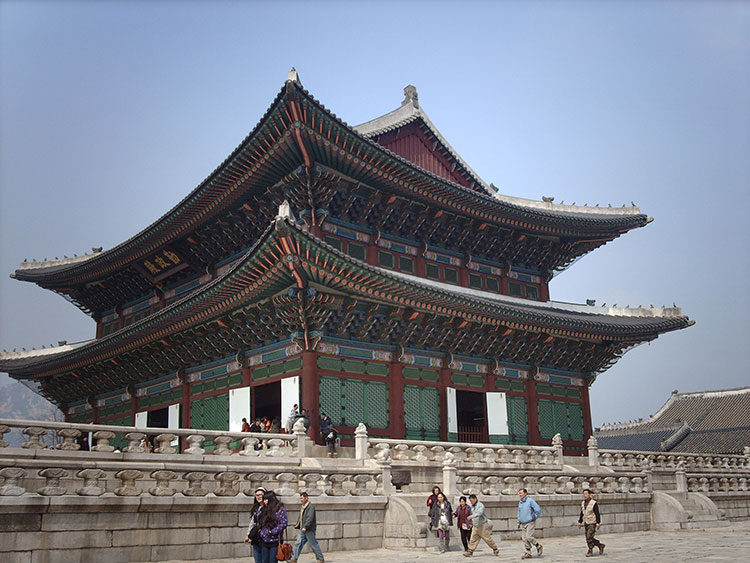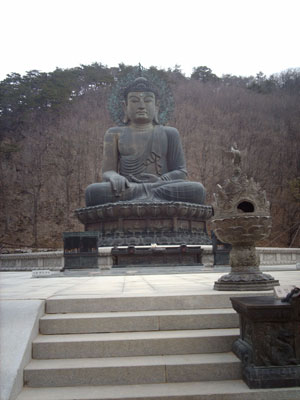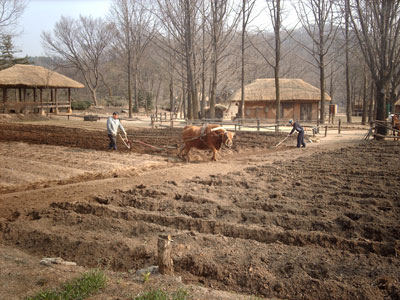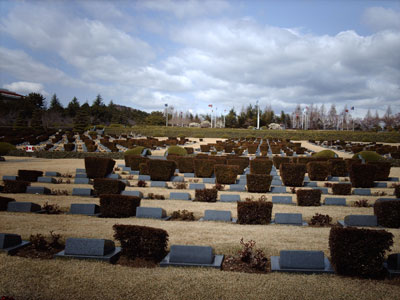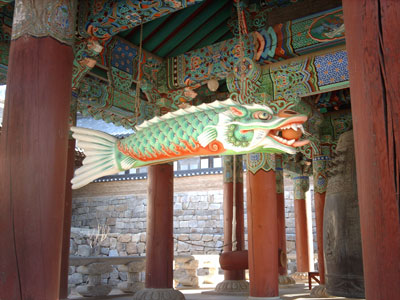South Korea – risen like a phoenix from the ashes of a country torn
This article appears on page 44 of the May 2013 issue.
Lynn Remly; Hudson, OH
After the United States dropped the bomb on Nagasaki, the State Department drew a fateful stroke on the map of Asia. The 38th Parallel was to be the line in the sand that prevented Communist influence from spilling off the Korean Peninsula onto Japan and the rest of the Pacific. That line still exists today, creating a country split in two after centuries of unified civilization.
Visiting South Korea
I decided that it was high time to visit South Korea, so I chose a 9-day, March-April ’12 excursion with Adventures Abroad (800/665-3998), which offered an overview of the geography, history, culture and current status of the country. The tour cost $3,395, single, with discounts available for early booking and paying in cash.
Knowing that I would arrive late at night, I also booked an airport-hotel transfer with Adventures Abroad for $75, which brought me to the Seokyo Hotel, on the north side of the Han River, after a 45-minute drive from Incheon Airport.
Like the other hotels on this trip, the Seokyo was slightly out at the elbows, though it was not too bad. The carpets were stained, the walls were marked and the bath smelled of mold, but it was quiet and comfortable and offered a very nice breakfast, comprising both Western and Eastern dishes. After enjoying kimchi along with my cornflakes for breakfast the next morning, it was clear that I wasn’t in Kansas any longer!
Located in the Hongik University district, the hotel offers proximity to hundreds of restaurants (including Pizza Hut, Burger King and KFC for the homesick) along with Starbucks-style coffee shops, and convenience stores. Off the main drag in front of the hotel, the buildings seemed dumped together in a hodgepodge; like many large cities in Asia, the northern side of Seoul had grown with no overall plan. Yet most signs were in Korean and English, making it feasible for visitors to navigate the city on their own.
The water in Seoul is said to be safe to drink, but there was a daily bottle of water supplied in my room anyway. There was a coffee maker but no coffee or tea or cups — no problem for me, since I always travel with a baggie with tea, instant coffee, sugar and instant soup packets plus a plastic mug, just in case. The desk staff spoke minimal English, but it was better than nothing, and computers and free WiFi in the lobby made communication with the outside world easy.
A quick note on a unique Korean hotel feature that I noticed — all the rooms offered a thick rope to use in case of fire. Yes, you are expected to rappel down seven or fifteen stories if a conflagration breaks out! I’ve seen this in all of the Korean hotels I’ve visited, even those abroad (in Vladivostok, for example), and I can’t even imagine what the powers that be must be thinking.
Starting in Seoul
I had arrived a full day early to get used to the time shift. I walked everywhere, but it’s easy to get around at minimal cost on the Seoul subway, where signs are in English as well as Korean.
Of the 50 million people living in South Korea, more than 10 million live in Seoul, a sprawling city that reflects the country’s history. The older part of town, almost flattened in the Korean War, occupies the north side of the Han River and includes most of the historic sites; the south side is home to the 5-star hotels, fine shops and broad boulevards.
After two nights on my own, I met the other five people in my group and our guide, Ben, and we set off in our van to see the presidential residence, called the Blue House because of its colored roof tiles. The “house” actually comprises 20 buildings, and only the exterior can be viewed, of course.
A statue of a phoenix opposite the Blue House, surrounded by statues of families, proclaims the message that Korea has risen from the ashes of war and now hopes for peace.
As proof of their hope, we noted huge numbers of Chinese and Japanese tourists as we trekked through the country. The National Folk Museum, for example, was crammed with Chinese tourists, some of the millions of Chinese who visit annually, according to our guide. In 2010, about 8.8 million foreign tourists visited South Korea, mainly from China, Japan, Taiwan and Hong Kong. Americans are very popular.
Unfortunately, this crowding made our visit to the museum too hurried to see much. Overall, the museum represents everyday life in the Joseon Dynasty (1392-1910), and it features farming implements and a kimchi display. Outside, wooden poles carved with monstrous faces represent the traditional means of scaring evil influences away from villages.
Exploring the city
We next visited Gyeongbokgung Palace, actually a complex of many buildings that was the country’s main royal residence until it was destroyed in 1592 in one of many wars with Japan. There is still a royal family, according to our guide, but they have only a ceremonial function. The influence of Chinese architecture is obvious everywhere in the complex, but the under-floor heating, vented by elaborately decorated chimneys, is a Korean specialty.
Our guide took us for a quick shopping/lunch/coffee break in Insadong, the quarter most popular with visitors. On a 200-yard-long street of restaurants, shops, galleries and souvenir stands, we had time for a quick lunch of black noodles (noodles with black bean sauce) and a bit of souvenir hunting.
Our final stop on the whirlwind city tour was the Korean Folk Village, which comprises traditional thatched and tiled houses, a temple, a Confucian school, a magistrate’s house and other buildings transported from all over the country to illustrate Korean life throughout history. We watched a drum dance, an acrobat on a tightrope and a traditional wedding ceremony, which gave us a handshake acquaintance with various aspects of Korean culture.
Overall, our visit to Seoul was far too rushed; we all agreed that it would have been better to add a day or two in the city to the itinerary.
Both breakfast and dinner were included on the tour daily. Lunch was easy enough to come by at a market or a service stop on the highway, usually at a cost of $4-$5.
On our last evening in Seoul, Ben took us for dinner at a small, traditional restaurant with a charcoal grill at each table, used to cook meat which was then eaten in lettuce leaves with many toppings and side dishes, including mung beans, kimchi, tofu, etc., plus seaweed soup. As a vegetarian, I had no trouble finding enough to eat.
A bit of history
Our 4-hour drive the next day to Mount Seorak National Park took us through snow-covered mountains. Because rain was forecast for the following day, Ben decided to detour to Goseong Unification Observatory so we could look over into the Demilitarized Zone (DMZ), a 2½-mile-wide fortified no-man’s-land established as a permanent boundary between North and South Korea when an armistice agreement was signed, halting the hostilities of the Korean War.
The 1950-53 war between the Republic of Korea, supported by the United States and the United Nations, and the Democratic People’s Republic of Korea, supported by China and the Soviet Union, was hideously destructive.
After Japan, which had occupied Korea since 1910, surrendered at the end of World War II, the North established a communist government and the South a capitalist one. The 38th Parallel became a political border and was the site of cross-border attacks and fights, culminating in the invasion of the South by North Korean forces on June 25, 1950.
World War III seemed likely to break out as the UN finally drove northern troops up past the 38th Parallel, almost to the border with China, which then entered the war on the North Korean side. Partly because the US had the bomb and had used it, the shooting ended on July 27, 1953, when the armistice agreement was signed.
When former president Bill Clinton visited it, he called the DMZ the scariest place on Earth, but he visited the section just north of Seoul, where troops stand nose to nose and shootings and other incidents still occur occasionally.
Our view from the Goseong Observatory seemed, to me, sad rather than scary. Chain-link fence, electrified and topped with barbed wire, stretched for miles and miles along the beautiful beaches of the East Sea (Sea of Japan), presumably to prevent infiltration or even escapes from the North.
At any rate, the border sites receive thousands of visitors yearly, and the sight of hundreds of teenagers on a field trip eating junk food and being more or less oblivious to the border, itself, kept this place from seeming particularly scary.
In fact, while we noticed an increased military presence as we drove northward, we also remarked on a new, unused highway stretching from South to North Korea, running alongside the Inter-Korea Transit Center building. The South is bent on reestablishing relations between the two countries, and there are already joint ventures between the North and South as well as a new train station at Panmunjom waiting for the day when trains will connect them.
Into the mountains
After the observatory, we continued into the mountains to Mt. Seorak National Park. One wag commented that if Korea were ironed out, it would be the size of China, and, indeed, 70% of the peninsula is mountainous. In this region, it is actually more like 90%, with forested slopes, dramatic granitic outcrops and rushing streams.
The centerpiece of the park is Seoraksan mountain, still covered in late March and early April with snow and ice. We checked into the Mt. Seorak Tourist Hotel, the only hotel in the park.
Though not new, the hotel was extremely well maintained, with basic furniture, including a comfortable bed, a TV, a mini fridge, and WiFi in the lobby — and those nice, warm floors. The manager spoke excellent English and was very helpful, as were the restaurant staff. Our rooms had balconies looking out over the mountains, framed by trees.
There were restaurants and concessions nearby, but the area was very quiet, especially after the park closed in the evening. Our dinner in the hotel’s restaurant was excellent.
After an American breakfast, we headed up the mountain in a cable car, ascending 3,600 feet in five minutes, then climbed farther over stairways and granite rocks to an observation peak. The snowy and slippery conditions made the climb tricky. I had only sneakers, and it would have been much better to tackle the route in light hiking shoes or snow boots.
Once back down on terra firma, we walked to the Sinheungsa Temple compound (much of the park terrain actually belongs to the temple). A very ancient Zen center, Sinheungsa dates to the seventh century AD, though it was rebuilt in its present form, after numerous fires, in the 17th century.
Said to be the oldest Zen temple in the world, Sinheungsa houses The Great Unification Buddha, a 48-foot-tall, 108-ton, hollow gilt-bronze statue that contains three pieces of the Buddha’s sari as well as original Buddhist scriptures. As its name suggests, the statue yet again reflects the Korean people’s wish for the rejoining of its divided country.
We were free to find lunch in the nearby town and then spend the afternoon in a local swimming-and-sauna complex, but most of us elected to hike along several trails in the fresh, cold air.
Shortcomings
Our next destination was Haeinsa Temple, where an overnight stay among the monks was scheduled. There was a great deal of confusion and dissatisfaction about this stop. Our itinerary description was very brief, indicating only “Overnight in Haeinsa.” No one, including me, had realized that this meant an overnight stay at the temple, itself, though our hotel list did show this.
Someone asked about the facilities, and our guide explained that we’d sleep on the floor and that the bathroom was “outside.” At that point, two people flatly refused to stay at the temple or to eat there, and they went to a nearby hotel. As it turned out, I shared a large double room with another woman, and we each had a bathroom with a toilet and handheld shower.
Unfortunately, this misinformation was the rule and not the exception. Our guide, Ben, was mediocre at best. His English was very poor, and he had great difficulty understanding anything we asked, to say nothing of responding. We quickly just gave up asking questions and, as a result, got a lot less out of the tour than we could have.
The bus was equipped with a microphone, but rather than tell us something during our long drives, he spent the entire time chatting with the driver. At lunch stops he disappeared for a smoke, leaving us to deal with whatever system was in place to get food.
He also seemed uninformed. He thought, for example, that we were spending one night in Gyeongju rather than two, and at the end of the trip he took me to the wrong terminal at the airport.
Others on the trip said that an Adventures Abroad guide usually goes along with each tour as an overseer — and there was one on the tour of Japan that immediately followed — but our group was apparently too small to justify an additional guide. We could have used an overseer.*
Temple stay
In any event, the four of us who opted for the temple stay were divided by gender before we changed into our temple clothes (padded baggy pants and jackets). A plan on our wall explained the temple rules and gave the schedule for our day, but we also were given an orientation by a charming young Korean woman who had taken her job, she said, in order to learn more about Buddhism. Because she had lived in Los Angeles with an aunt and, consequently, spoke decent English, she was assigned to help out with some of the temple visitors.
We were taught to bow and prostrate ourselves formally before the Buddha and were instructed to follow our guide in single file throughout the temple grounds, eyes straight ahead, without talking, hands folded in front as we walked.
She later gave us a basic explanation of Buddhism, and we talked about various things — where we were from, why we were there and so on. We continued on to the main hall to join the monks in prayer and had tea, made in the traditional way.
The highlight of this stay, for me, was seeing the Tripitaka Koreana, a UNESCO World Heritage treasure. This Korean collection of Buddhist scriptures was carved in the 13th century onto more than 81,000 wooden printing blocks, with no known errors. Created in the faith that they would protect the country from Mongol invaders, the blocks are stored in buildings with natural ventilation, which has preserved the wood for more than 700 years.
Following our tour we joined the monks for dinner, though we sat apart from them to eat our rice, broth with kale, pancake, kimchi and weak tea. After more discussion about the purpose of our visit, we went to bed very early in order to be up by 3 a.m. to join the monks for prayers, followed by 108 prostrations (“I prostrate myself for an arrogant mind,” etc.) and a nap before breakfast at 6:10, followed by another nap and a tour of the complete grounds.
Our last meeting was a casual chat over coffee with our guide and her assistant, another young woman, who was a flautist and had studied in Vienna. We admired a CD of her playing and she very kindly gave each of us a copy. Finally, it was time to change clothes and rejoin the two group members who had rejected the temple stay.
Gyeongju
We then drove to Gyeongju. Typically, we stopped for lunch along the way while traveling from one destination to the next. Koreans eat very fast, and so did we. Most of our lunches lasted 20 minutes and dinner, maybe an hour.
I should note that we found clean, Western-style toilets everywhere we went.
Gyeongju is Korea’s ancient capital and the cultural heart of the country. It is also a resort destination, with parks, Ferris wheels, lakes and so on.
The city’s prosperity in the late seventh century permitted the development of unique art and architecture, contributing to the establishment of a peninsular culture distinct from those of neighboring China and Japan. Its historic areas have been designated by UNESCO as important ancient cultural sites.
We walked first around Anapji Pond, an artificial lake in what is now Gyeongju National Park, constructed by order of King Munmu in AD 674. This ornamental water feature that once belonged to the Banwolseong Palace, no longer in existence, was dredged and reconstructed in 1974 as part of a project to renovate historic sites.
Excavations revealed almost 33,000 relics, including gilt bronze figures of Buddha, ornamental roof tiles, pottery, jewelry and everyday items. We saw about 730 pieces that are displayed at the Anapji Exhibition Hall, a gallery of the Gyeongju National Museum.
Our hotel was the Concorde, a huge, Las Vegas-style hotel minus the casino. Again, it had seen better days but was still comfortable, with all the amenities. Our first breakfast there was American style, served individually, and the second was a large buffet of Eastern and Western cuisine, probably because of a large group of Japanese tourists who had arrived the night before.
Our itinerary in Gyeongju included a number of historic sites, starting with Bulguksa Temple, a major temple of the Jogye Order of Korean Buddhism. In 1995, Bulguksa was added to the UNESCO World Heritage List, along with the nearby Seokguram Grotto, our next destination.
Seokguram is a small artificial grotto of granite symbolic of a spiritual journey into Nirvana. The centerpiece of the sanctuary is a seated, 10-foot-tall stone Buddha. Once again, reaching the grotto required a great deal of walking and climbing on somewhat uneven steps. As usual, there was no special handicapped access.
Finally, we walked along the Tumuli Park Belt, which consists of three groups of royal tombs shaped like domes. A small museum contained some of the rich findings from the tombs, including the Heavenly Horse, a mural painting of a winged horse on a birch-bark saddle flap.
Busan
Our final stop of the tour was Busan, one of the world’s largest ports and the second-largest city in Korea. Our guide took us first on an unplanned but very welcome visit to the United Nations Memorial Cemetery in Korea, where soldiers from the UN countries that fought in the 1950-53 war are buried. Overall, there were 40,896 UN casualties from 17 nations.
Unfortunately, exceptionally high winds canceled our planned excursions in Busan — a scenic mini-train ride and a river cruise. Busan, however, is home to a huge outdoor/indoor market, set up at both street level and underground, so we spent the afternoon shopping.
I was disappointed again not to find any souvenirs. (The market is a source of clothes, shoes and daily items.) Possibly because the country receives few tourists interested in such things, there were almost no remembrances of the places we visited. Memo — if you see something in Insadong or in a museum shop, buy it. You may not have a second chance.
Left wanting more
On the final day, I parted from the group, all of whom were headed on an Adventures Abroad trip to Japan, to spend two days by myself in Seoul. I booked a room ($161 per night, including breakfast) at the Ramada Seoul Dongdaemun (phone 82 22 2763500), located on the south side of the river, not the historic north side. The staff spoke excellent English, and a shuttle every 20 minutes connected the hotel to Incheon Airport ($15 one way).
The south side was built after the Korean War to accommodate a burgeoning population. Huge apartment complexes have sprouted up everywhere along with thousands of shops.
My main interest was rambling the streets looking to see how people live, but this is the city’s high-end shopping district, centered on the Galleria, where shops like Armani, Jil Sander and Louis Vuitton enjoy a brisk trade. There was not much local color.
Overall, it seemed to me that South Korea deserved more time for exploration than I had on this tour, and I would happily revisit the country for a longer stretch. If nothing else, I learned of a country with a tortured past that has — like its central image, the phoenix — risen many times from the ashes to live a new and prosperous life.
*ITN sent a copy of Lynn Remly’s review of her guide, Ben, to Adventures Abroad and received the following reply from Martin T. Charlton, the company’s Assistant Manager/Destination Specialist: “It is great to read that Ms. Lynn Remly enjoyed many of the unique experiences on our tour to South Korea. There is a lot of sightseeing packed into this tour.
“It is, of course, unfortunate that she was not satisfied with the leadership of the local guide, Ben. Please appreciate that we have worked with Ben before, as he has been leading tours for us in South Korea for several years. In the past, his reviews have only been positive. We can only apologize for the fact that he did not perform up to the standards expected on this departure. We have since spoken with him at length about his performance. Perhaps he had become complacent, which is very unfortunate, and therefore he was not performing at 100%.
“We train all of our local guides and tour leaders and expect them to behave in a certain way. A large percentage of repeat travelers often note that it is the quality of our guides and leaders that bring them back to us year after year. We hope that Ms. Remly will appreciate that this was a ‘one-off’ situation, and we look forward to seeing her travel with us again.”

